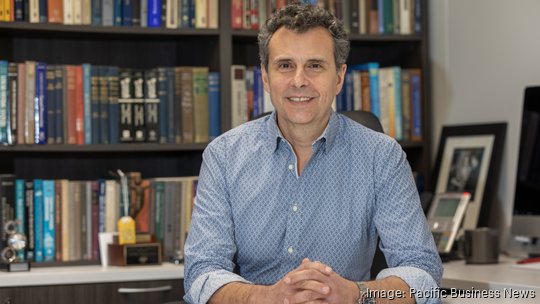
As the vice president for research and innovation for the University of Hawaii System, Vassilis L. Syrmos said his main goal is to “provide faculty a place of excellence where their research can thrive and their ideas can flourish.”
And Syrmos has a first-hand perspective on what faculty need — he started at UH Manoa in 1991 as a professor of electrical engineering. He went on to serve as associate dean of the College of Engineering and then as associate vice chancellor for research, before assuming his current role in 2013.
“I thought it was quite an opportunity to take all the great things that the university does in the research area into innovation, and then from innovation through entrepreneurship activities into commercialization,” he said of the move into his current role.
“Not all new knowledge [from a university’s research] actually results in inventions and innovation, but there are areas where that is the case, and taking that into an invention and innovation is difficult,” he said. “Then taking that into a business model is even more difficult because at that point, you have to commercialize it. … Most of the faculty are not trained in that type of activity.”
That’s where his office comes in. The Office of the Vice President for Research and Innovation leads the planning, development and coordination of research and innovation efforts throughout the UH system. This includes managing the university’s research awards, which surpassed half a billion dollars this year. It also encompasses the Academy for Creative Media System, STEM Pre-Academy, the Applied Research Laboratory, the Office of Innovation and Commercialization, and the Office of Indigenous Knowledge and Innovation.
What is currently your biggest priority? For me, the biggest priority is to sustain and maintain the research enterprise for the University of Hawaii System, both in quality and in quantity. That drives everything else — it drives the innovation, it drives the commercialization, and it drives retaining great faculty. … We have to make sure that our resources support the existing areas of excellence, and then at the same time, be opportunistic to advance other areas that we think have potential in the future.
Tell me about some of the new programs that your office has started recently. We have been fortunate to be funded by the federal government — by the Office of Naval Research, the National Science Foundation, and the U.S. Economic Development Administration — and we have developed four different programs in order to facilitate the pathway from early concept to a product.
We start with Patents2Products, which supports faculty and post-doctoral students that do research. When they see things that can be commercialized or patented, they can bring them into our office, and we help to turn that into commercialization.
We couple that with our Faculty Fellows program … where we try to inject innovation and entrepreneurship ideas into the general education curriculum. The most common approach is to do innovation and entrepreneurship outside of the curriculum — you have events, you have competitions, and those are good things to have — but what this does is take these ideas and put them in as part of the main curriculum.
Then we have Hacking4X, which is a semester-long course for students and faculty on different topics — we have Hacking4Defense, Hacking4Health, Hacking4Environment — where teams learn to see how they can solve certain problems. That has been so popular, both with our students and the community as a whole.
Finally, there is our incubator [called HITIDE, or the Hawaii Technology Innovation Development Ecosystem], which takes startups, and funds and mentors them for one to two years to … give a longer runway for them to fly on their own. … HITIDE is open to individuals, teams or startups with UH-affiliated, science-based technologies who want to commercialize and create real-world impact. ... We had our first cohort, and we had three companies — two in the energy space, and one in material sciences. We have our second cohort now that has five companies — one is a medical application, three are in space science, and one is in engineering design.
What would you say is currently the biggest challenge facing the tech and innovation space in Hawaii? One of the major roadblocks in startups or innovation … is the [lack of] CEOs that have actually taken startups from launch to an exit — whether that is an IPO or a buyout. [This person is responsible for] all of the wraparound services in a startup to bring it from a mom-and-pop kind of a business into the next level. Those types of individuals are not laying around everywhere in Hawaii. To me, that would be the No. 1 challenge for startups.
Second would be that most of the venture funding is on the Mainland, especially if you are trying to raise Series B, Series C [funding] — there is no way you are going to raise that kind of money here. And then venture investors want their companies in their backyard, so what is going to happen, if [a company] is successful and they raise [funding], they are going to pack up and leave … and that is unfortunate.
What is a leadership lesson you learned in transitioning from a professor to an administrator? One thing I’ve learned is to try and do your job so that the end result is excellent. … Mediocrity breeds mediocrity, and excellence breeds excellence — that is a common thread from research to administration.
Vassilis L. Syrmos
Vice president for research and innovation, University of Hawaii System
Address: 2425 Campus Road, Sinclair 10, Honolulu, HI 96822
Phone: 808-956-5006
Website: research.hawaii.edu



